The ethereal beauty of elven warriors, mages, and rangers has captivated our imagination through countless fantasy tales, and their distinctive hairstyles remain one of their most iconic features.
Whether you’re preparing for a cosplay event, designing a character for your next gaming session, or simply seeking inspiration for a bold new look, the flowing locks and intricate braids of male elves offer endless possibilities.
This comprehensive guide explores 26 cool elf hairstyles for male elves inspired by fantasy worlds, covering everything from battle-ready warrior braids to elegant high-elven styles that embody timeless grace.
You’ll discover practical styling techniques, cultural significance behind various elven hair traditions, and tips for adapting these mystical looks to real-world applications.
Each hairstyle represents a unique aspect of elven culture, from the woodland rangers who blend with nature to the noble court advisors who radiate sophistication, ensuring you’ll find the perfect style to match your vision of elven elegance and power.
Contents
- 1 1. The Classic Woodland Ranger Flow
- 2 2. The Battle-Braided Warrior
- 3 3. The Half-Up Elven Knot
- 4 4. The Silvered Elder’s Cascade
- 5 5. The Warrior’s Side Sweep
- 6 6. The Nature-Bound Crown Braid
- 7 7. The Diplomatic Curtain Style
- 8 8. The Archer’s Practical Plait
- 9 9. The Mystical Middle Part Flow
- 10 10. The Rebellious Undercut Warrior
- 11 11. The Ceremonial High Braid
- 12 12. The Windswept Wanderer
- 13 13. The Tactical Temple Ties
- 14 14. The Sophisticated Side Part
- 15 15. The Moonlight Silver Cascade
- 16 16. The War-Painted Mohawk Braid
- 17 17. The Scholarly Low Ponytail
- 18 18. The Festival Flower Crown
- 19 19. The Rogue’s Messy Topknot
- 20 20. The Royal High Crown
- 21 21. The Seafaring Salt-Sprayed Style
- 22 22. The Assassin’s Hooded Style
- 23 23. The Druid’s Natural Locks
- 24 24. The Duellist’s Tied-Back Elegance
- 25 25. The Timekeeper’s Braided Clock
- 26 26. The Phoenix Flame Gradient
- 27 External Resources for Elven Hair Inspiration
- 28 Conclusion
1. The Classic Woodland Ranger Flow
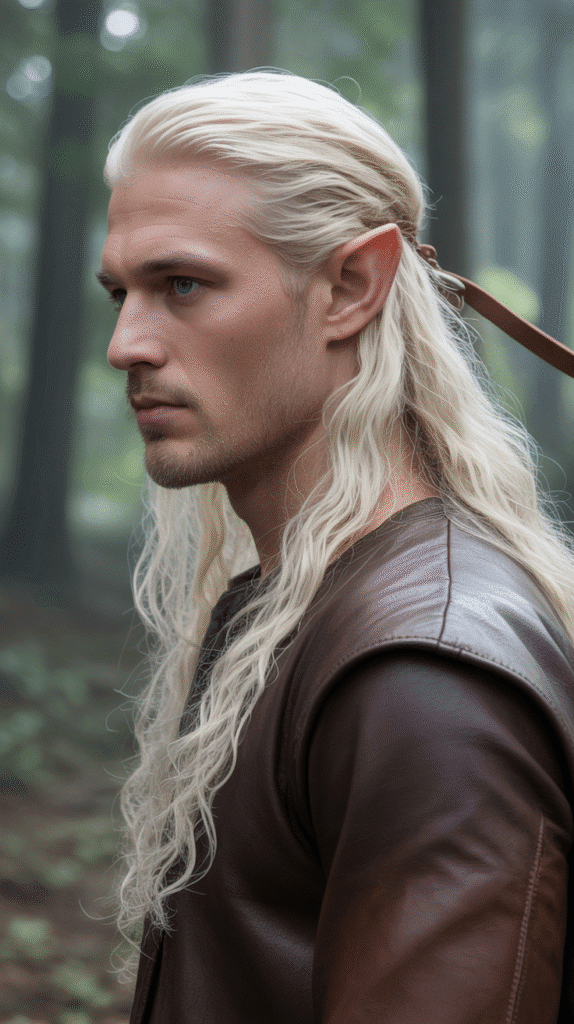
The woodland ranger style embodies the freedom and connection to nature that defines many forest-dwelling elves.
This effortless yet purposeful look combines long, flowing hair with subtle functional elements that keep strands away from the face during combat or tracking.
The style represents the perfect balance between aesthetic beauty and practical wilderness survival.
Key Features:
- Length reaches mid-back to waist level, allowing natural movement while maintaining warrior practicality
- Face-framing layers cascade around the jawline and shoulders, creating dimension and movement
- Subtle leather or natural fiber ties secure small sections near the temples
- Natural texture with slight waves mimics the organic patterns found in forest environments
- Strategic layering prevents hair from tangling during archery or sword combat
Styling Approach:
- Begin with clean, slightly damp hair to enhance natural texture patterns
- Apply lightweight leave-in conditioner focusing on mid-lengths to ends for healthy shine
- Use fingers to create loose separation rather than combs for a more natural appearance
- Secure two small sections from temples backward with leather cording or natural materials
- Allow the remaining hair to flow freely down the back without excessive styling products
Cultural Significance:
- Represents the elven philosophy of harmony with natural surroundings
- Demonstrates trust in one’s abilities without excessive armor or constraints
- Symbolizes the wanderer’s spirit and connection to ancient forests
2. The Battle-Braided Warrior
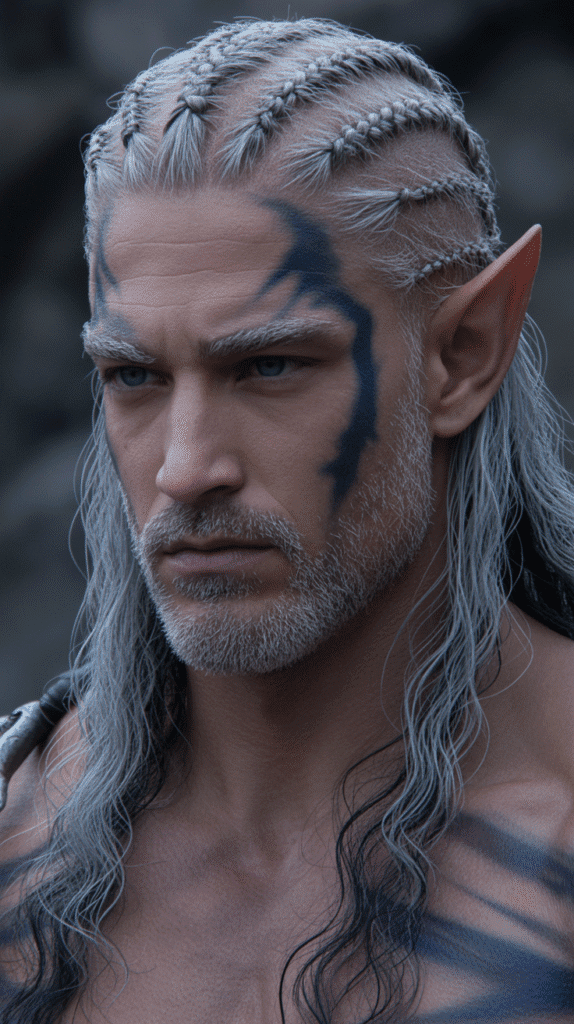
War-focused elves require hairstyles that combine intimidating presence with absolute functionality.
The battle-braided warrior style features multiple tight braids that keep hair completely secured during intense combat situations.
This practical yet striking appearance has become synonymous with elven military traditions across fantasy literature and media.
Construction Elements:
- Multiple cornrow-style braids begin at the hairline and travel backward along the scalp
- Four to six primary braids create a symmetrical pattern that distributes weight evenly
- Small metal rings or beads mark significant battles or achievements
- Braids converge at the crown or upper back, either ending or combining into a single plait
- Undercut sides (optional) reduce maintenance and enhance the fierce appearance
Practical Benefits:
- Zero hair interference during helmet wearing or combat maneuvers
- Braids remain secure for multiple days during military campaigns
- Easy to maintain in field conditions with minimal tools
- Intimidation factor projects strength and dedication to warrior culture
- Scalp protection from minor cuts during close-quarters combat
Styling Duration:
- Initial braiding requires 2-4 hours depending on hair length and braid complexity
- Maintenance needed every 5-7 days to prevent loosening
- Can last up to two weeks with proper nighttime protection
3. The Half-Up Elven Knot
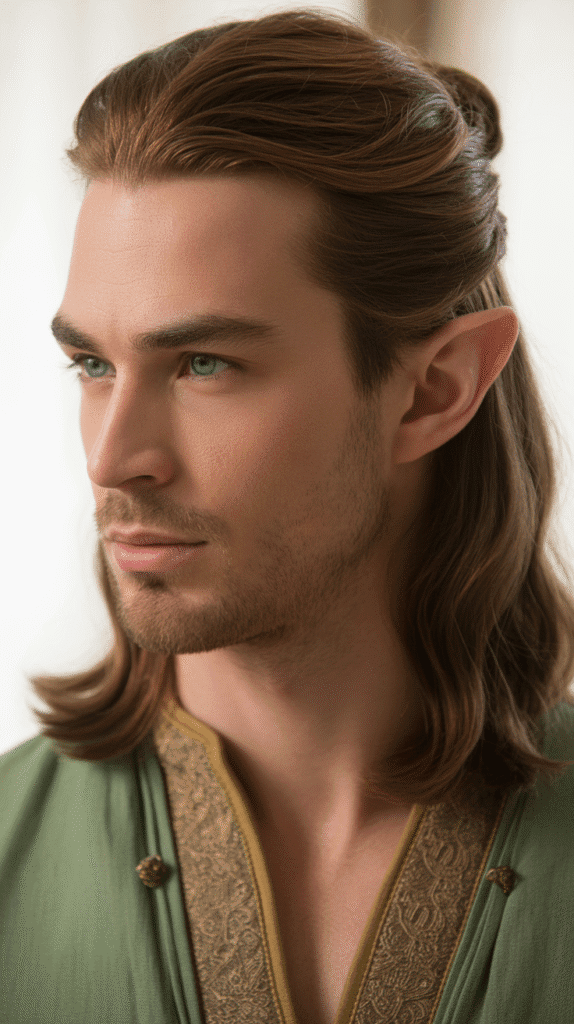
This refined style represents the intersection of casual elegance and practical sophistication.
The half-up elven knot secures the upper portion of hair while allowing the remaining length to flow freely, creating a look that’s equally appropriate for council meetings or forest patrols.
The style has gained popularity due to its versatility and relatively simple execution.
Structural Components:
- Upper section gathered from temples to crown, comprising about 40% of total hair volume
- Twisted or knotted at the crown to create a secure anchor point
- Lower section flows naturally to showcase hair length and texture
- Decorative pin or natural element secures the knot for added visual interest
- Face-framing pieces (optional) soften the look and add dimension
Ideal Hair Types:
- Works best with medium to long hair (shoulder length or longer)
- Suitable for straight, wavy, or loosely curled textures
- Requires moderate thickness to create substantial knot presence
- Can be adapted for finer hair with texturizing products
Versatility Factors:
- Formal events: Add metallic accessories or jeweled pins for elevated elegance
- Combat readiness: Ensures vision remains clear without full commitment to braiding
- Daily wear: Comfortable for extended periods without causing tension headaches
- Climate adaptability: Keeps neck exposed in warm conditions while maintaining style
4. The Silvered Elder’s Cascade
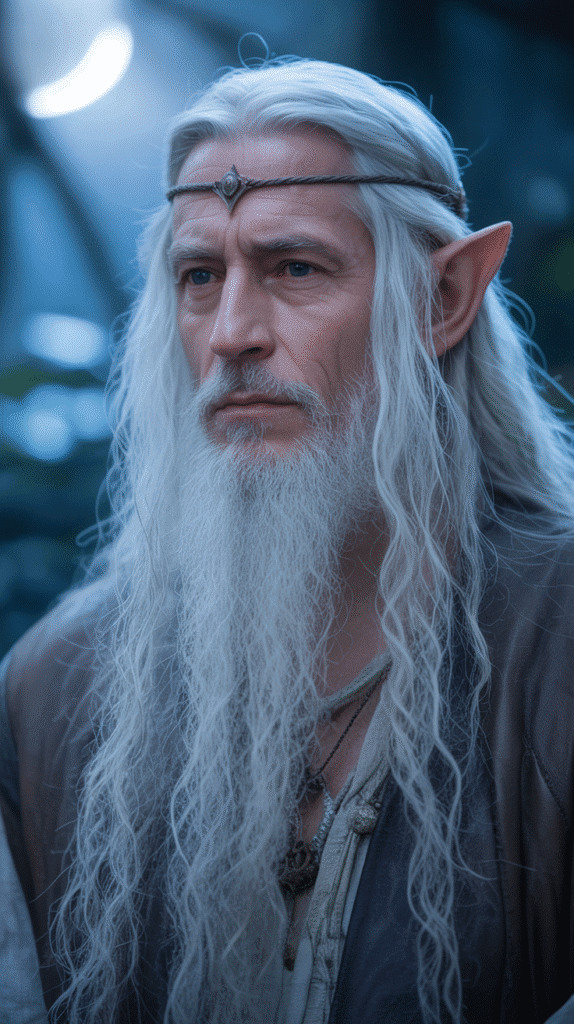
Wisdom and age command respect in elven societies, and the silvered elder’s cascade reflects centuries of accumulated knowledge.
This distinguished style emphasizes length, natural silver or white coloring, and minimal intervention to allow hair’s inherent beauty to shine.
The look embodies patience, refinement, and connection to ancient traditions.
Defining Characteristics:
- Exceptional length often reaching below the waist to demonstrate years of careful cultivation
- Natural silver, white, or platinum tones that develop with age and wisdom
- Minimal styling interventions preserve the hair’s organic flow and texture
- Simple center or slight side part frames the face without elaborate manipulation
- Possible subtle crown or circlet rests atop the head as symbol of status
- Immaculate condition despite length, showing dedicated care and elven vitality
Maintenance Philosophy:
- Regular cleansing with gentle, natural ingredients maintains shine without stripping
- Deep conditioning treatments preserve strength and prevent breakage
- Protective sleeping arrangements using silk or satin prevents tangling
- Minimal heat styling preserves hair integrity across centuries
- Trimming split ends maintains healthy appearance despite extreme length
Symbolic Meaning:
- Represents accumulated wisdom and connection to elven history
- Demonstrates patience and long-term thinking characteristic of immortal beings
- Serves as living record of personal journey and experiences
- Commands automatic respect in elven hierarchical structures
5. The Warrior’s Side Sweep
Combining asymmetry with fierce practicality, the warrior’s side sweep draws all hair to one shoulder, creating dramatic visual impact while maintaining combat readiness. This style has become iconic in fantasy media for characters who balance aesthetic presence with battlefield effectiveness. The pronounced asymmetry creates natural movement and can be quickly adjusted for different situations.
Technical Execution:
- All hair directed to one side, typically the non-dominant hand side for weapon accessibility
- Secured at shoulder level with leather wrap, metal clasp, or decorative tie
- Upper sections smoothed tightly against the scalp to prevent interference
- Volume concentrated at the gathering point creates impressive visual weight
- Optional braid from gathering point downward for additional security
Strategic Advantages:
- Keeps dominant side clear for sword drawing or bow handling
- Creates distinctive silhouette that aids in battlefield recognition
- Allows rapid adjustment by releasing the tie for full hair freedom
- Protects one shoulder with natural hair padding under armor
- Maintains style integrity even during vigorous physical activity
Variation Options:
- Loose sweep: Minimal securing for casual or ceremonial occasions
- Braided sweep: Multiple braids gather to one side for maximum security
- Adorned sweep: Incorporate beads, rings, or charms along the length
- Undercut combination: Shave opposite side for extreme asymmetry
6. The Nature-Bound Crown Braid
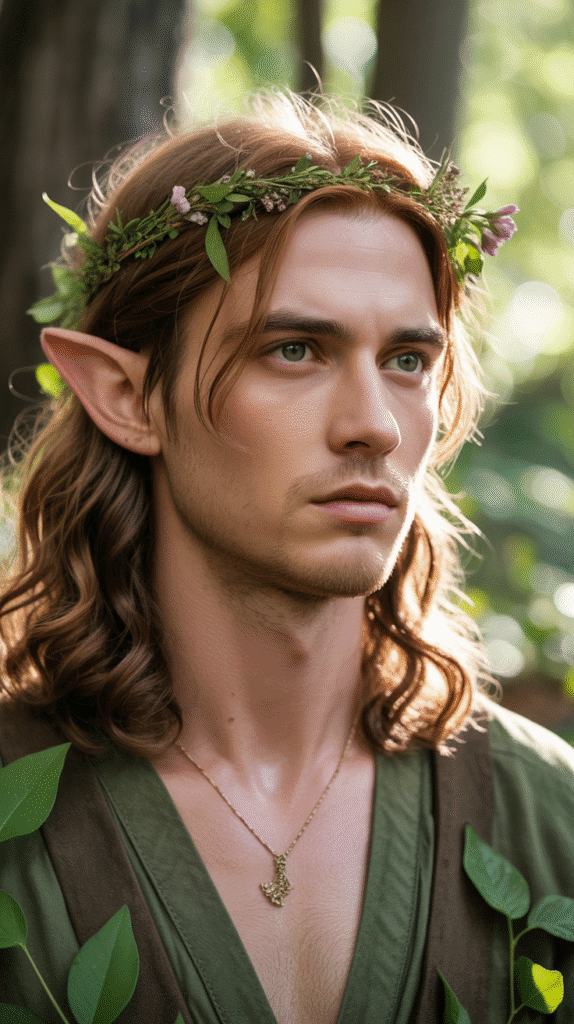
Forest elves often incorporate living elements into their appearance, and the nature-bound crown braid literally weaves natural materials into the hairstyle itself.
This enchanting style creates a halo effect around the head while allowing remaining hair to flow naturally.
The look represents the ultimate fusion of elven beauty with woodland environments.
Construction Method:
- Dutch or French braid circles the head from one temple around to the other
- Natural elements woven in including small flowers, leaves, thin vines, or feathers
- Braid sits approximately 1-2 inches back from the hairline
- Remaining hair flows freely from beneath the crown braid
- Braid ends tucked discreetly or incorporated into the flowing hair
Natural Element Selection:
- Flowers: Choose hardy varieties that won’t wilt quickly (baby’s breath, small roses, wildflowers)
- Leaves: Select pliable types that can flex without breaking (ivy, fern fronds)
- Vines: Use thin, flexible varieties that integrate smoothly (morning glory, thin grapevine)
- Feathers: Incorporate as accent pieces representing spirit animals or totems
- Crystals or stones: Small specimens on thin wire represent earth connection
Seasonal Adaptations:
- Spring: Cherry blossoms, new growth, pastel wildflowers
- Summer: Vibrant blooms, green leaves, full flowers
- Autumn: Changing leaves, berries, wheat stalks, warm tones
- Winter: Evergreen sprigs, holly, preserved flowers, crystalline elements
7. The Diplomatic Curtain Style
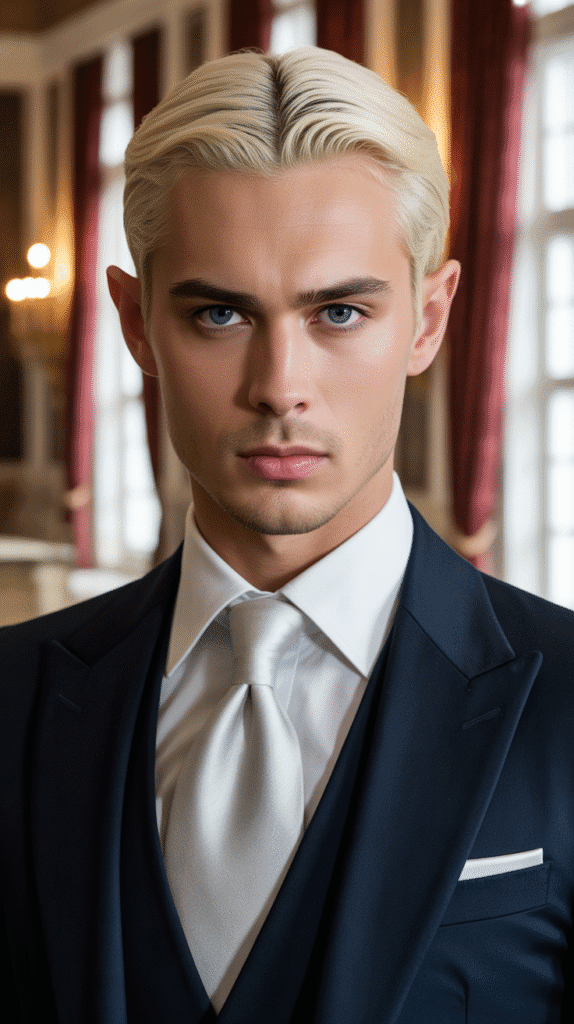
High elven diplomats and court members favor refined looks that project authority without aggressive warrior energy.
The diplomatic curtain style features perfectly groomed, face-framing sections that create a sophisticated “curtain” effect around the face while remaining hair maintains pristine organization.
This polished appearance has become standard among elven political classes.
Structural Details:
- Precise center part divides hair into symmetrical halves
- Face-framing sections cut to chin or shoulder length create the curtain effect
- Remaining length pulled back smoothly or allowed to flow with pristine grooming
- High shine finish achieved through quality hair care and finishing products
- Absolute symmetry demonstrates attention to detail and diplomatic precision
Styling Requirements:
- Blow-dry with tension using round brush to create smooth, polished finish
- Light styling products provide hold without visible residue or stiffness
- Regular trimming maintains perfect length and shape of curtain sections
- Color maintenance keeps blonde, silver, or chosen tone vibrant and even
- Daily grooming ritual ensures consistent appearance for diplomatic functions
Psychological Impact:
- Symmetry projects trustworthiness and balanced judgment
- Polish demonstrates respect for diplomatic proceedings
- Refined appearance puts others at ease during negotiations
- Maintains tradition while appearing approachable and modern
- Non-threatening aesthetic facilitates peaceful discourse
8. The Archer’s Practical Plait
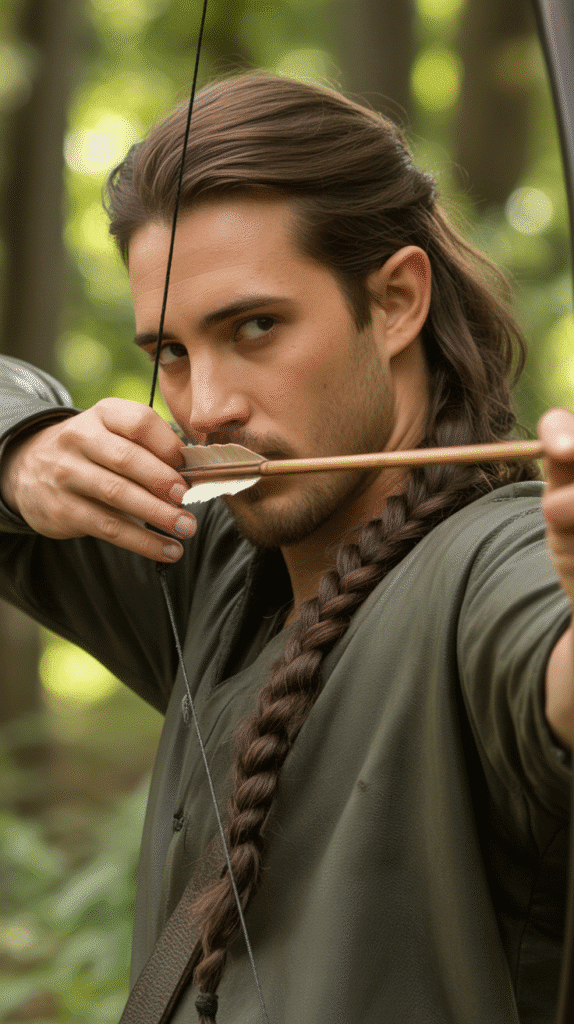
Elven archers require absolute certainty that their hair won’t interfere with bowstring draw or arrow flight.
The archer’s practical plait combines a single, thick braid down the back with complete hair control that still allows for impressive length display.
This utilitarian style has transcended its functional origins to become a classic elven look.
Braiding Specifications:
- Single three-strand braid begins at the crown or upper back
- Tight initial tension gradually loosens toward the bottom for natural taper
- Secured with leather tie at the bottom, positioned mid-back to hip depending on length
- All hair incorporated including shorter layers around the face
- Smooth top section ensures bowstring clearance during shooting stance
Performance Features:
- Zero interference with bowstring path during draw and release
- Weight distribution keeps hair centered down the spine
- Quick execution allows archer to prepare rapidly for patrol or combat
- Durability maintains throughout day-long hunting expeditions
- Easy release for social situations or when maximum awareness needed
Customization Elements:
- Feather fletching tied into braid bottom honors archery tradition
- Leather wrapping at intervals provides grip points and visual interest
- Colored cord weaving denotes archery achievements or unit affiliation
- Small bells or charms can alert to predators when desired
9. The Mystical Middle Part Flow
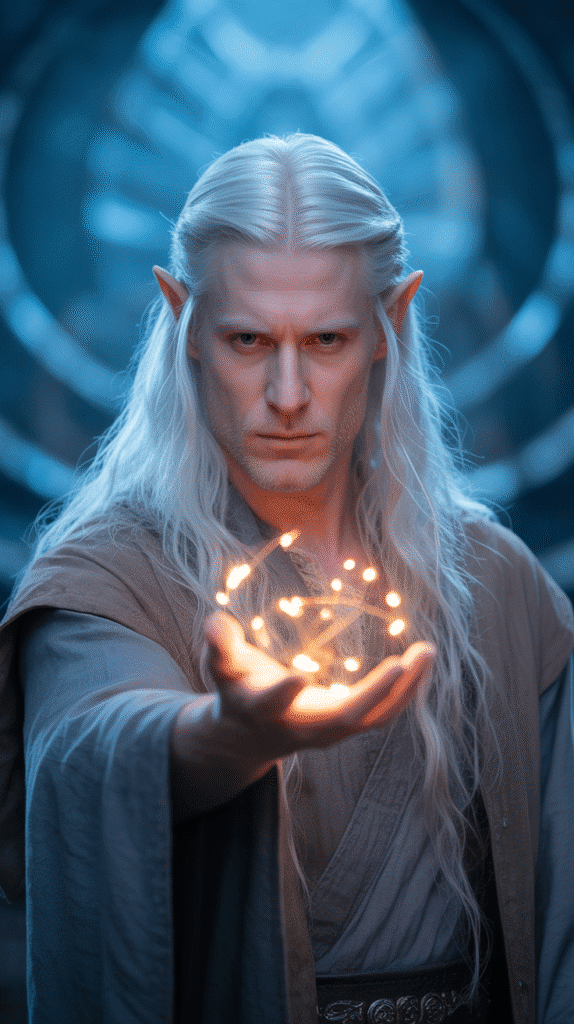
Elven mages and spell-casters often favor styles that emphasize their connection to mystical energies.
The mystical middle part flow creates perfect symmetry while allowing hair to channel and display magical energies during casting.
This elegant yet powerful style has become associated with elven sorcery across fantasy traditions.
Core Elements:
- Razor-sharp center part divides hair with geometric precision
- Even length on both sides creates balanced energy flow
- No securing or braiding allows hair to move freely and respond to magical forces
- Significant length (typically waist-length or longer) provides canvas for energy display
- Pristine condition essential for proper mystical energy conduction
Magical Considerations:
- Hair acts as conduit for channeling and directing magical energy
- Symmetry enhances spell precision and power balance
- Length correlates with magical capacity in some elven traditions
- Color often manifests magical specialization (white for general magic, other tones for specific schools)
- Movement patterns during casting can indicate spell type or power level
Care Requirements:
- Specialized cleansing rituals remove magical residue buildup
- Energy-infused conditioning maintains hair’s conductive properties
- Protection from magical backlash prevents damage during intense casting
- Regular meditation while caring for hair strengthens mystical connection
- Avoidance of metallic accessories that could interfere with energy flow
10. The Rebellious Undercut Warrior
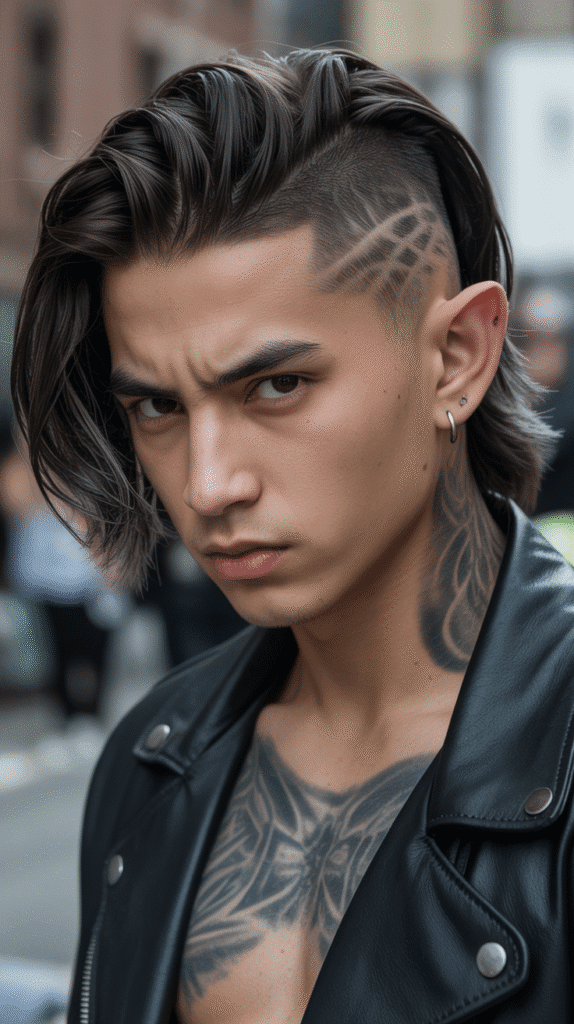
Younger elven warriors or those who reject traditional conventions often choose the rebellious undercut warrior style.
This dramatic look combines shaved or closely cropped sides with substantial length on top, creating stark contrast that challenges elven aesthetic norms.
The style represents independence, modern thinking, and willingness to forge new traditions.
Style Architecture:
- Sides and back clipped to 1/8 inch to 1 inch, creating clean contrast
- Top section maintains significant length, typically 8-16 inches
- Clear demarcation line between shaved and long sections
- Top hair styled backward, to side, or in topknot depending on preference
- Optional designs shaved into the short sections for additional rebellion
Cultural Statement:
- Challenges traditional long-hair-as-status-symbol paradigm
- Embraces practicality over centuries-old aesthetic conventions
- Signals generation shift within elven societies
- Attracts both criticism from traditionalists and admiration from peers
- Represents individual over collective identity focus
Maintenance Schedule:
- Shaved sections require touch-ups every 7-10 days to maintain crispness
- Long section needs standard care to prevent damage
- Design elements (if present) need refreshing every 2-3 weeks
- Style commitment requires regular barber or self-maintenance skills
- Growing out period (if desired) takes 6-12 months for sides to reach significant length
11. The Ceremonial High Braid
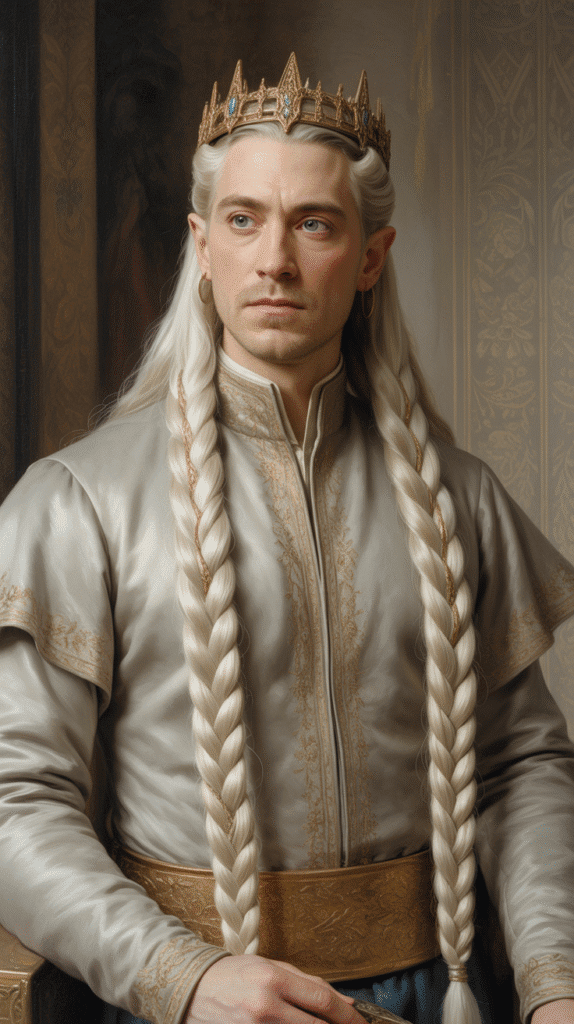
Reserved for the most significant elven ceremonies, the high braid represents the pinnacle of formal hair styling.
This elaborate construction begins at the crown and incorporates intricate patterns, precious materials, and symbolic elements that convey status and purpose.
Few styles command as much respect or require as much skill to execute properly.
Construction Complexity:
- Begins at front hairline or crown with elaborate gathering technique
- Multiple braiding styles incorporated into single structure (fishtail, Dutch, rope braids)
- Precious materials woven throughout including metallic threads, small gems, pearls
- Symbolic patterns represent specific ceremonies or achievements
- Can take 4-8 hours to complete with assistance from skilled hair artisans
Ceremonial Applications:
- Coming of age rituals marking transition to full adulthood
- Bonding ceremonies celebrating partnerships or marriages
- Coronations or ascensions to leadership positions
- Victory celebrations after successful military campaigns
- Magical initiations when mages achieve new power levels
Symbolic Elements:
- Gold threads represent solar connection and divine favor
- Silver threads indicate lunar influence and mystical power
- Gemstone colors correspond to specific virtues or achievements
- Braid patterns tell stories of lineage and accomplishment
- Number of sections may indicate rank within hierarchy
12. The Windswept Wanderer

Some elves embrace a deliberately untamed aesthetic that suggests constant travel and adventure.
The windswept wanderer style appears effortlessly casual while actually requiring specific techniques to achieve the perfect balance of controlled chaos.
This look embodies freedom, adventure, and rejection of overly refined society.
Achieving the Look:
- Start with clean, towel-dried hair to provide workable texture
- Apply sea salt spray or texturizing product throughout
- Scrunch and tousle with hands to create deliberate disarray
- Allow to air dry or use diffuser on low setting
- Strategic piece-y separation creates intentional rather than neglected appearance
- Face-framing strands fall naturally without rigid structure
Length Considerations:
- Works best with shoulder-length to mid-back hair
- Layering essential for creating proper movement and dimension
- Shorter layers around face provide framing without appearing styled
- Longer underlayers give substance and prevent excessive volume
Maintenance Reality:
- Despite casual appearance, requires daily restyling to maintain proper effect
- Products must be refreshed to prevent flat, greasy look
- Regular washing prevents product buildup that ruins texture
- Occasional trims maintain layer integrity and prevent split ends
- Weather dependent – high humidity or rain can either enhance or destroy the look
13. The Tactical Temple Ties
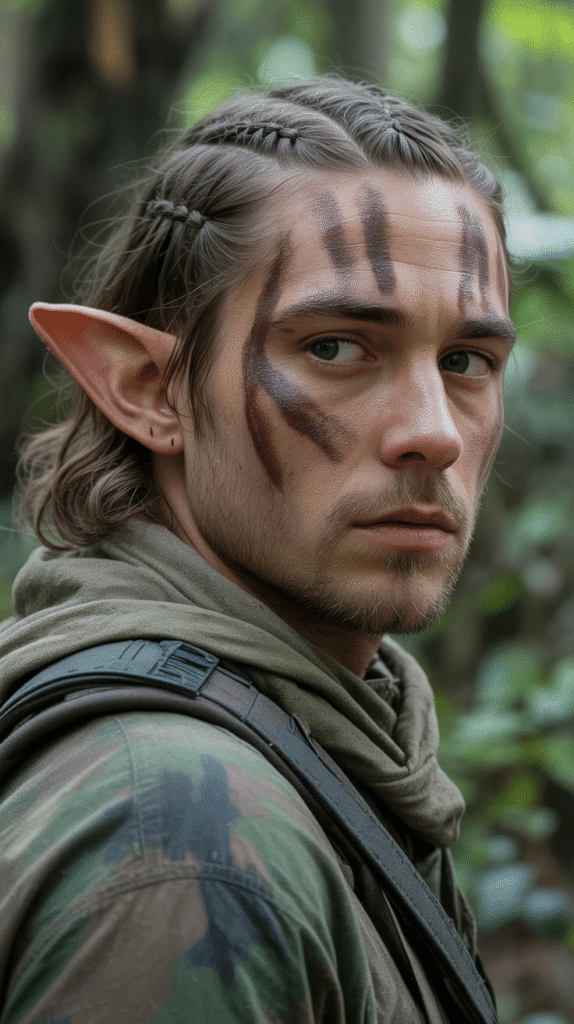
Military scouts and reconnaissance specialists favor this minimalist approach that keeps hair controlled without elaborate styling.
The tactical temple ties secure only what’s necessary for vision and movement while leaving most hair free for temperature regulation and cultural identity.
This practical compromise has gained popularity beyond purely military contexts.
Implementation Steps:
- Section small portions from each temple, approximately 1 inch wide
- Create tight braids or twisted sections from these portions
- Pull back and secure at back of head with small tie or clasp
- Remaining hair flows naturally without interference
- Position ensures peripheral vision remains clear
Tactical Advantages:
- Minimal styling time allows rapid deployment readiness
- Maintains elven identity while meeting practical combat needs
- Easy adjustment for changing tactical situations
- Comfortable for extended wear under helmets or hoods
- Quick release when returning to non-combat situations
Material Selection:
- Leather cord provides durability and silence during movement
- Natural fiber ties blend with forest environments
- Metal clips (darkened) offer security without reflection
- Elastic bands allow flexibility but may not fit aesthetic preferences
14. The Sophisticated Side Part
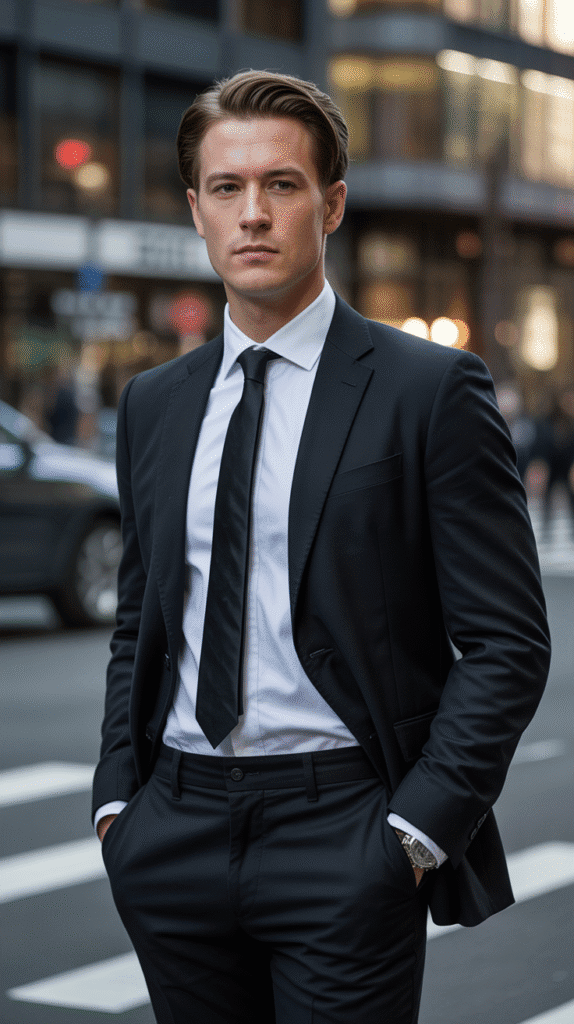
Urban elves and those who interact regularly with other races often adopt this more universally understood elegant style.
The sophisticated side part demonstrates refinement without exotic elaboration, making it ideal for merchants, ambassadors, and elves who bridge multiple cultural worlds.
The style projects professionalism while maintaining distinct elven grace.
Styling Technique:
- Create defined side part positioned approximately 2-3 inches from center
- Comb smoothly in directions dictated by the part
- Apply light pomade or styling cream for polished finish
- Consider length – works equally well with shoulder-length or shorter hair
- Maintain clean lines through regular grooming and trimming
Professional Applications:
- Trade negotiations where exotic appearance might create distance
- Banking and finance roles requiring conservative presentation
- Academic settings that value polished intellectual appearance
- Government liaison positions bridging elven and human authorities
- Entertainment industry where refined but not theatrical look fits
Cross-Cultural Bridge:
- Familiar to humans and other races, reducing “otherness”
- Maintains elven elegance without overwhelming observers
- Demonstrates adaptability and willingness to meet others halfway
- Projects competence through polish and attention to detail
- Allows accessories like glasses or earpieces without conflict
15. The Moonlight Silver Cascade
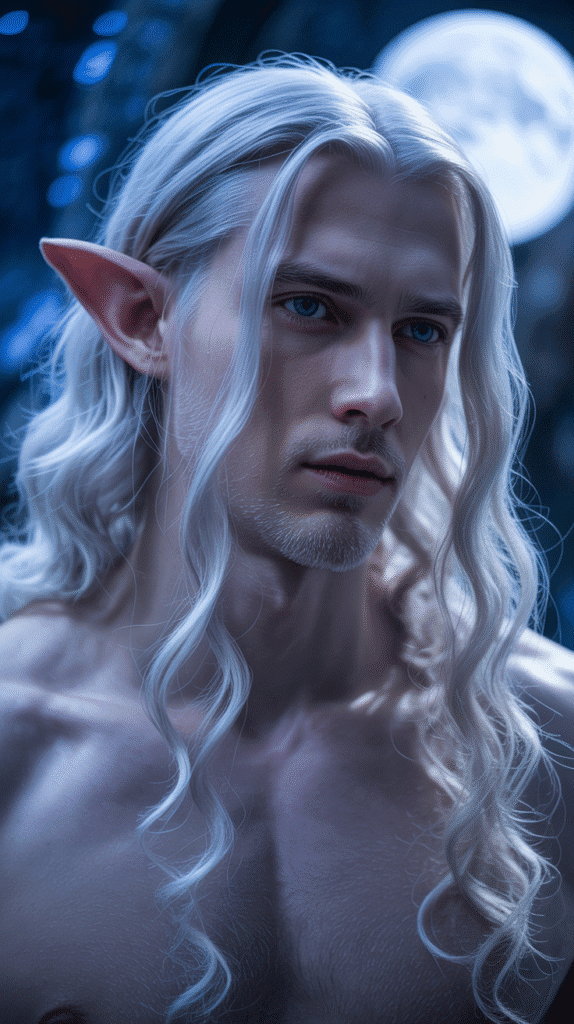
Some elves are blessed with naturally silver or white hair regardless of age, creating an otherworldly appearance.
The moonlight silver cascade emphasizes this ethereal coloring through careful maintenance and styling that maximizes luminosity and flow.
This striking look has become synonymous with moon elves and night-dwelling elven subcultures.
Color Maintenance:
- Purple-toning treatments prevent yellow or brassy undertones in white hair
- Regular deep conditioning maintains shine and prevents dullness
- UV protection products prevent sun damage that can yellow silver tones
- Avoid chlorine and harsh chemicals that compromise color integrity
- Professional color correction if natural silver needs enhancement
Styling for Maximum Impact:
- High-shine products emphasize the metallic quality of silver hair
- Smooth styling without excessive texture shows color uniformly
- Length showcased to display the full cascade effect
- Minimal accessories avoid distracting from the hair’s natural beauty
- Lighting awareness – style photographs especially well in moonlight or cool-toned artificial light
Cultural Associations:
- Moon elves consider silver hair a mark of divine favor
- Night hunters use the pale color to blend with moonlit environments
- Magical practitioners believe silver hair enhances lunar magic
- Romantic symbolism associated with mystery and otherworldly beauty
16. The War-Painted Mohawk Braid
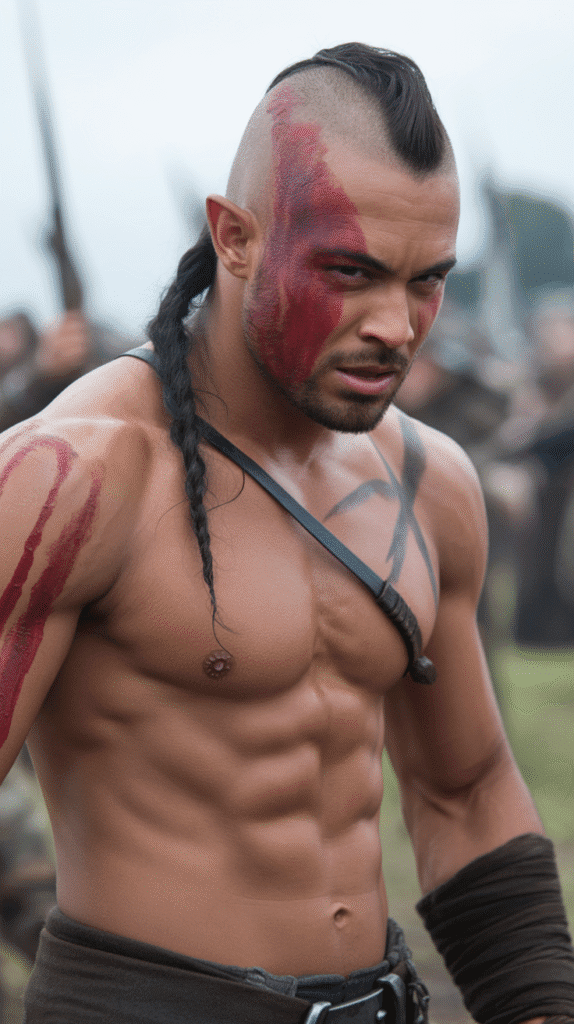
Among the most aggressive elven warrior styles, the war-painted mohawk braid leaves shaved or closely cropped sides while the center strip is braided into a dramatic raised crest.
Combined with traditional war paint, this look projects maximum intimidation and combat readiness.
The style deliberately inverts typical elven aesthetic softness into sharp-edged ferocity.
Construction Method:
- Sides shaved to 1/8 inch or completely smooth
- Center strip left 4-8 inches wide from forehead to nape
- Strip braided tightly in raised French braid technique
- Braid stands upright through natural hair support or light product
- War paint applied to shaved sections in tribal or unit patterns
Combat Psychology:
- Intimidation factor increases effectiveness before combat begins
- Unit identification through specific mohawk width or braid pattern
- Psychological armor boosts wearer’s confidence and aggression
- Enemy demoralization through display of commitment and fearlessness
- Cultural statement rejecting peace-focused elven stereotypes
Maintenance Challenges:
- Daily reshaping required to maintain upright braid
- Side shaving needs attention every 3-5 days
- Braid integrity must be preserved during combat
- War paint requires reapplication before each engagement
- Social situations may require alternative styling or acceptance of reactions
17. The Scholarly Low Ponytail

Elven academics, librarians, and researchers favor understated styles that won’t interfere with study while maintaining appropriate dignity.
The scholarly low ponytail offers simplicity, comfort, and practicality for long hours spent reading, writing, or conducting research.
This humble style has persisted for millennia among elven intellectual classes.
Style Characteristics:
- Hair gathered at the nape of the neck
- Loose to moderate tension avoids headaches during extended wear
- Secured with simple leather tie, ribbon, or basic elastic
- No elaborate decoration keeps focus on intellectual rather than aesthetic pursuits
- Comfortable for hours of seated study without adjustment
Practical Benefits:
- Keeps hair away from manuscripts and delicate materials
- Prevents ink stains or chemical damage during experiments
- Allows comfortable positioning of head while reading or writing
- Compatible with spectacles without hair interference
- Maintains professionalism without effort or attention
Intellectual Tradition:
- Associated with famous elven philosophers and scholars throughout history
- Demonstrates priorities – mind over appearance
- Signals accessibility to students seeking guidance
- Transcends fashion through centuries of consistent use
- Unifying style across diverse elven academic specializations
18. The Festival Flower Crown
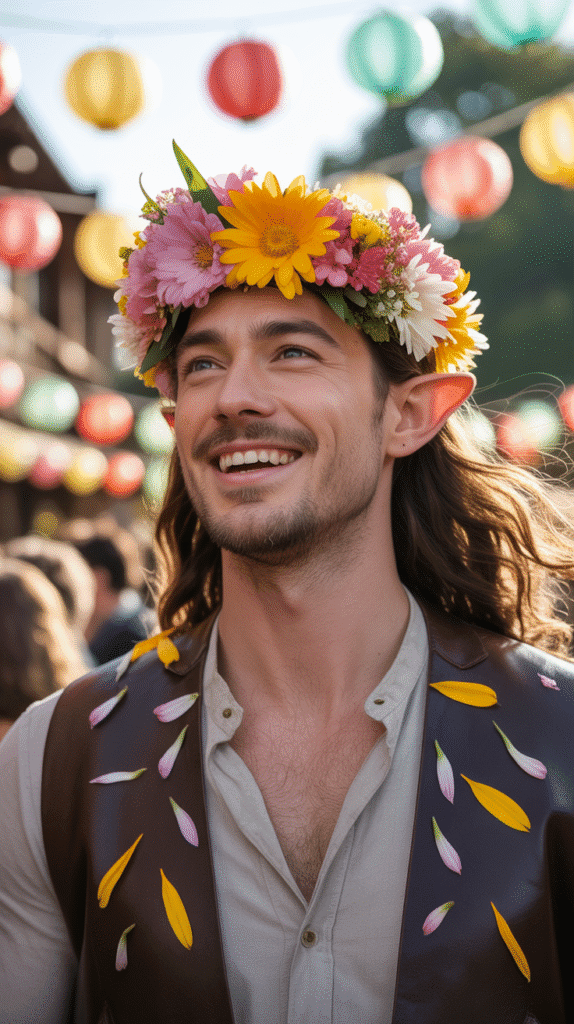
During celebrations and festivals, many elves embrace temporary decorative styles.
The festival flower crown transforms ordinary hair into living art through incorporation of elaborate floral arrangements.
This joyous style celebrates nature, beauty, and the temporary nature of perfect moments. The look varies dramatically based on season, region, and specific celebration.
Crown Construction:
- Flexible vine or wire base sized to head circumference
- Fresh flowers attached with floral wire or natural fibers
- Larger blooms positioned as focal points
- Smaller flowers and greenery fill spaces
- Ribbon or additional decorative elements based on festival theme
Flower Selection by Season:
- Spring: Tulips, daffodils, cherry blossoms, lilacs, hyacinths
- Summer: Roses, sunflowers, daisies, lavender, zinnias
- Autumn: Chrysanthemums, marigolds, asters, dried wheat, berries
- Winter: Evergreen branches, holly, preserved flowers, pinecones, white blooms
Festival Applications:
- Harvest celebrations incorporate wheat, fruits, autumn flowers
- Spring renewal festivals use fresh buds and pastel blooms
- Midsummer events feature sun-colored flowers and maximum abundance
- Bonding ceremonies include flowers significant to the couple
- Victory celebrations may include traditional victory flowers
19. The Rogue’s Messy Topknot

Elven rogues, thieves, and urban operators need hair completely secured but prefer styles that suggest casual nonchalance rather than military precision.
The rogue’s messy topknot achieves both goals through deliberately imperfect execution that keeps hair controlled while maintaining an “I didn’t try that hard” aesthetic.
This style has become popular beyond criminal circles.
Styling Process:
- Gather all hair at the crown using fingers rather than comb
- Twist loosely without excessive tension
- Wrap around base to create knot shape
- Secure with stick, tie, or pin in deliberately casual manner
- Pull out strategic strands to frame face and create “messy” effect
- Allow some pieces to escape naturally throughout the day
Functional Elements:
- Complete hair control for climbing, sneaking, or combat
- Quick execution taking under 60 seconds
- Easy to adjust or release rapidly
- Comfortable for extended wear during jobs or stakeouts
- Doesn’t attract attention in taverns or crowds
Psychological Factors:
- Suggests confidence through apparent lack of effort
- Disarms observers who expect more careful grooming
- Maintains mystery through studied casualness
- Projects coolness and urban sophistication
- Signals belonging to rogueish subcultures
20. The Royal High Crown
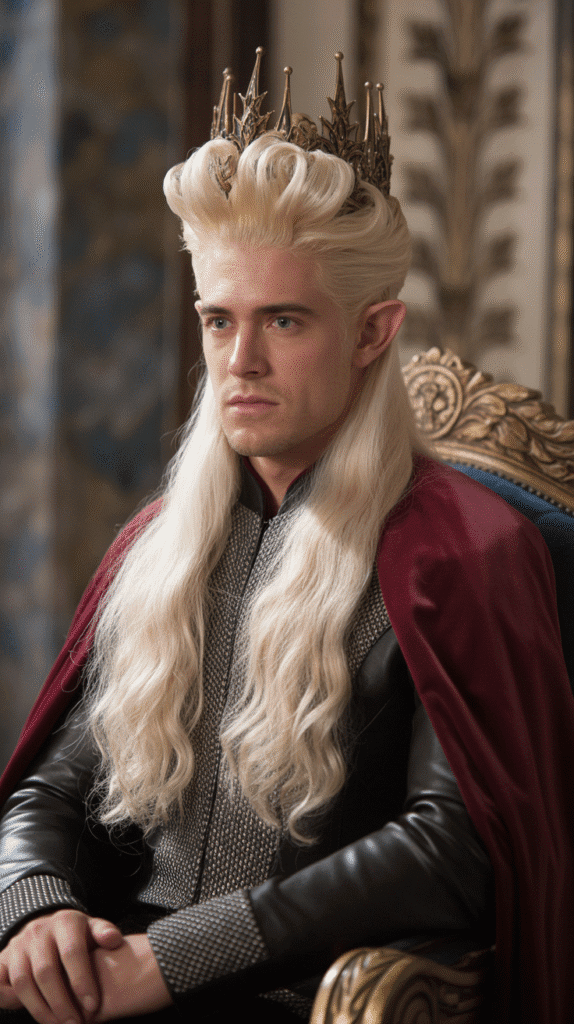
The highest-ranking elven nobles and royalty wear their hair in styles that literally elevate them above others.
The royal high crown involves complex upward styling that increases the wearer’s apparent height while displaying wealth through incorporated precious materials.
This commanding style has remained consistent across elven kingdoms for thousands of years.
Architectural Structure:
- Hair built upward in carefully constructed sections
- Internal supports may include wire frameworks for extreme height
- Sections braided, twisted, or rolled to create stable structure
- Crown or circlet integrated into the style itself
- Jewels, precious metals, and rare materials woven throughout
- Height can add 6-12 inches to wearer’s apparent stature
Status Indicators:
- Height correlates with rank within royal hierarchy
- Material value demonstrates kingdom’s wealth and power
- Complexity signals access to skilled hair artisans
- Maintenance requirements prove wearer’s freedom from manual labor
- Style consistency shows adherence to ancient traditions
Practical Considerations:
- Cannot be performed solo – requires assistants
- Takes 3-6 hours to complete depending on complexity
- Limits head movement and requires careful deportment
- Doorway clearance becomes genuine consideration
- Worn for specific ceremonial occasions rather than daily
21. The Seafaring Salt-Sprayed Style

Elven sailors and coastal dwellers develop a distinctive look influenced by constant exposure to ocean winds and salt water.
The seafaring salt-sprayed style embraces natural texture created by marine environments while maintaining enough control for shipboard activities.
This weather-beaten aesthetic carries its own rugged appeal.
Environmental Influence:
- Salt water exposure creates natural texture and volume
- Sun bleaching lightens tips creating natural highlights
- Constant wind trains hair into specific movement patterns
- Humidity effects produce wave or curl enhancement
- Ocean spray provides natural styling product effect
Practical Styling:
- Often pulled back partially or completely during sailing operations
- Leather ties or rope segments used as functional accessories
- Shorter overall length common to reduce maintenance at sea
- Bandanas or head wraps protect from sun while allowing style to show
- Embrace natural texture rather than fighting environmental effects
Cultural Elements:
- Shells, pearls, or sea glass incorporated as ornaments
- Rope or netting patterns in braids symbolize maritime connection
- Traditional knots from sailing applied to hair ties
- Weathered appearance demonstrates seafaring experience
- Bronze skin tone typically accompanies this sun-exposed style
22. The Assassin’s Hooded Style

Stealth operatives require hairstyles compatible with hoods and face coverings while maintaining quick transition capability.
The assassin’s hooded style keeps hair slicked back and flat against the skull, allowing seamless hood wear without bulk or sound.
This pragmatic approach sacrifices aesthetic flourish for operational effectiveness.
Technical Requirements:
- Absolute flatness against skull eliminates bulk under hoods
- Secured in tight bun or braid at base of skull, positioned low
- No loose strands that could escape hood or catch on equipment
- Silent movement – no beads, metal, or sound-producing elements
Product Selection:
- Strong-hold gel or pomade keeps hair immobile during operations
- Matte finish products prevent light reflection that could compromise position
- Water-resistant formulas maintain hold through rain or sweating
- Easy removal for post-mission cleanup and identity change
- Scent-free options prevent detection by targets or animals
Operational Benefits:
- Hood fits smoothly without adjustment or repositioning
- Peripheral vision unobstructed by stray hairs
- Facial coverings integrate seamlessly without hair interference
- Silent movement through elimination of hair rustling sounds
- Quick transformation to civilian appearance by releasing and restyling
Transition Strategy:
- Release secured hair after mission completion
- Apply dry shampoo or texturizing spray
- Tousle to create casual, non-suspicious appearance
- Transforms from operative to ordinary citizen in under two minutes
23. The Druid’s Natural Locks

Elven druids and nature priests often avoid any styling that seems to impose artificial will upon their hair.
The druid’s natural locks embrace whatever texture, wave, or curl pattern occurs organically, viewing hair as extension of natural self.
This philosophy produces styles as varied as the elves who wear them, united only by their commitment to authenticity.
Philosophy Foundation:
- Hair reflects natural state without chemical or heat intervention
- Growth patterns honored rather than corrected or redirected
- Texture embraced whether straight, wavy, curly, or coiled
- Natural color maintained without dyes or artificial enhancement
- Minimal cutting except to remove damage or maintain health
Care Approach:
- Natural cleansing using plant-based, chemical-free preparations
- Air drying exclusively to avoid heat damage
- Herbal treatments strengthen and nourish without alteration
- Natural oils from plants or nuts provide conditioning
- Finger detangling preferred over brushes or combs when possible
Incorporated Elements:
- Living plants may be encouraged to grow within the hair itself
- Feathers found in natural settings rather than harvested
- Seeds, acorns, or seedpods represent cycles of growth
- Small woodland creatures may nest temporarily (considered blessing)
- Moss or lichen in some extreme cases for ancient druids
Spiritual Significance:
- Represents surrender to natural forces rather than control
- Demonstrates trust in inherent perfection of natural forms
- Connects wearer directly to plant and animal consciousness
- Serves as living ecosystem supporting small life forms
- Marks wearer as true servant of nature rather than civilization
24. The Duellist’s Tied-Back Elegance
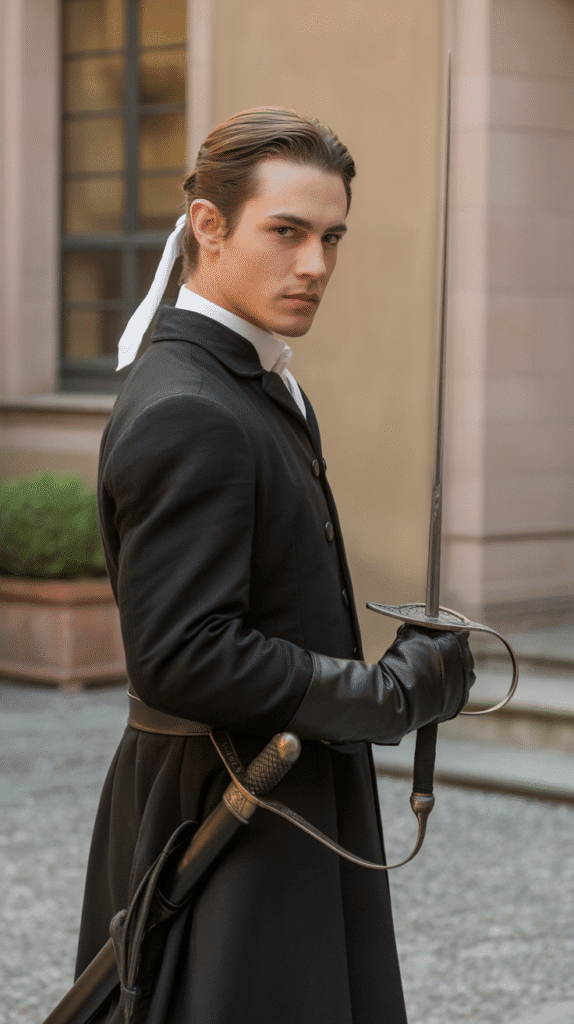
Elven duelists require absolute certainty that hair won’t interfere during precise sword combat while maintaining the elegance expected of formal challenge participants.
The duellist’s tied-back elegance balances these needs through refined securing techniques that showcase hair beauty while ensuring complete control.
This style has become associated with honor, precision, and deadly grace.
Style Components:
- All hair swept back from face with careful attention to symmetry
- Secured at mid-back or nape with elegant ribbon or silk tie
- Smooth top sections demonstrate control and precision
- Length displayed below the tie point showcases cultivation
- Decorative tie matches formal dueling attire colors
Combat Considerations:
- Zero visual obstruction during rapid blade work
- Weight balanced to prevent distraction during footwork
- Secure enough to survive rolls, lunges, or grappling
- Quick-release option allows rapid honor-bound transition to more aggressive style
- Maintains dignity even if struck or physically challenged during bout
Cultural Protocol:
- Ribbon color may indicate challenging or defending status
- Knot style shows school of swordsmanship affiliation
- Hair condition reflects personal honor and discipline
- Securing method follows formal dueling code requirements
- Post-duel tradition victor may request ribbon as trophy
Formal Applications:
- Honor duels following insult or dispute
- Tournament competitions displaying martial skill
- Coming-of-age blade trials for young warriors
- Formal demonstrations of swordsmanship techniques
- Romantic tradition partner’s ribbon worn during duels fought in their honor
25. The Timekeeper’s Braided Clock
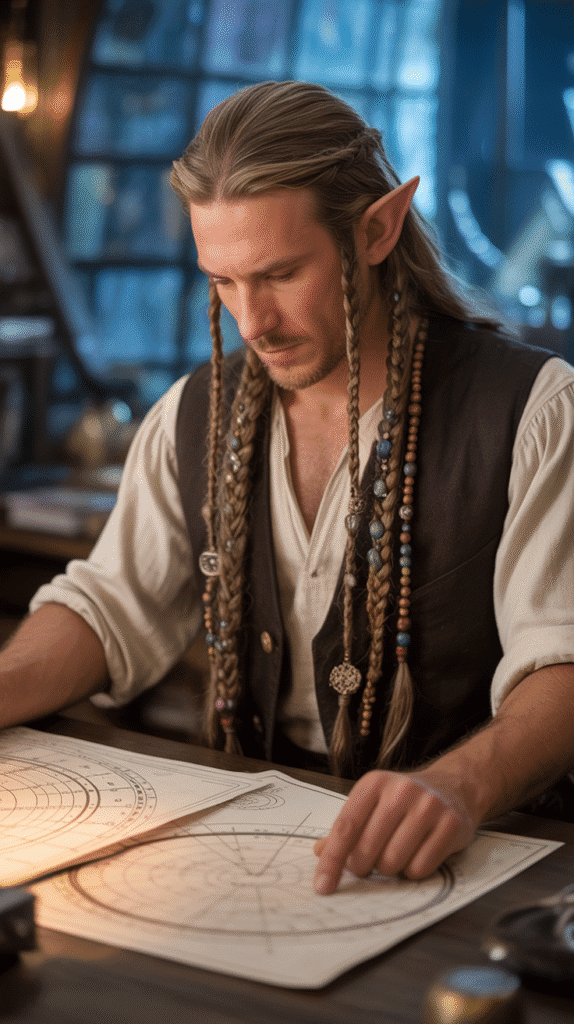
Among the most unusual elven styles, the timekeeper’s braided clock incorporates multiple braids of different lengths that represent various time cycles.
This functional art piece serves as both aesthetic choice and practical timekeeping tool for elves who track multiple temporal streams.
The style requires mathematical precision and deep understanding of cyclical time.
Structural Design:
- Multiple braids (typically 7-13) of deliberately varied lengths
- Each braid represents different time cycle (lunar, solar, seasonal, etc.)
- Beads or markers positioned at specific intervals along each braid
- Mathematical precision in braid length calculations
- New beads added as cycles complete and begin
Represented Cycles:
- Lunar phases tracked with 28-position braid
- Solar year represented by 365-position braid
- Seasonal markers show equinoxes and solstices
- Elven age cycles (often century-based)
- Astronomical events (eclipses, comets, planetary alignments)
- Historical commemorations marking significant past events
- Personal milestones tracking individual journey
Bead Symbolism:
- Material indicates cycle type (silver for lunar, gold for solar)
- Color represents specific meanings within each cycle
- Size shows importance of particular time markers
- Shape conveys whether marker is beginning, midpoint, or completion
- Arrangement patterns create readable temporal map
Practical Application:
- Glancing at braids provides immediate temporal orientation
- Useful for ritual timing requiring precise astronomical positioning
- Agricultural planning through seasonal cycle tracking
- Historical documentation preserving important date memories
- Teaching tool for young elves learning temporal magic
Maintenance Requirements:
- Must be recalculated and rebuilt every 7-10 years
- Requires advanced mathematical knowledge to maintain accuracy
- New beads must be added at precisely calculated moments
- Style cannot be worn by those lacking temporal magic understanding
26. The Phoenix Flame Gradient
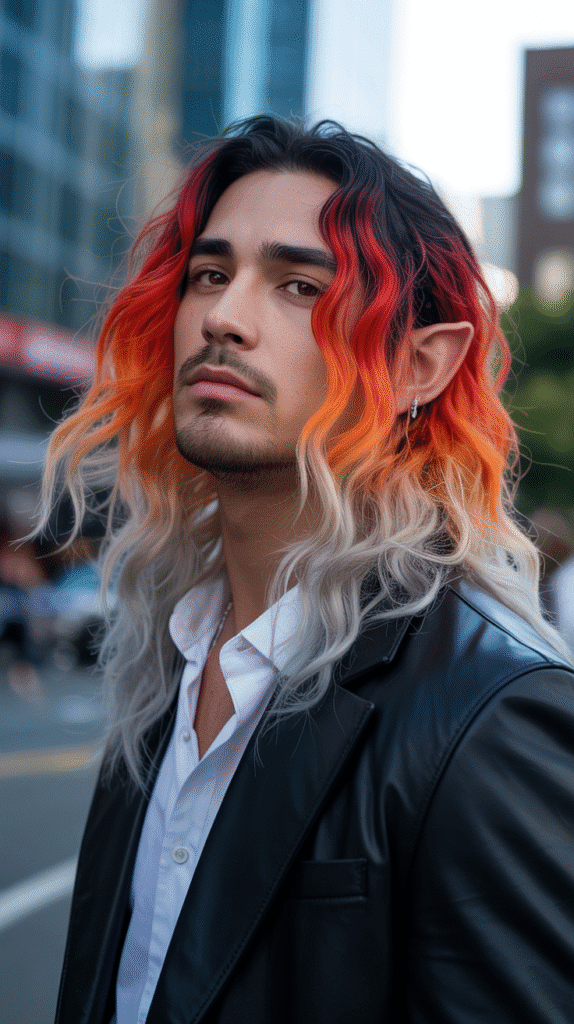
The most dramatic modern elven hairstyle, the phoenix flame gradient features color that transitions from natural dark roots through orange and red tones to bright blonde or white tips.
This bold choice represents transformation, rebirth, and rejection of traditional single-tone elven hair aesthetics.
The style has sparked controversy while gaining popularity among younger elves.
Color Progression:
- Dark roots (black, dark brown) provide natural anchor
- Transitional zone moves through deep red or burgundy
- Mid-lengths feature bright red, orange, or copper tones
- Ends lighten to golden blonde, platinum, or white
- Seamless blending between zones creates gradient effect
Application Technique:
- Professional colorist essential for proper gradient execution
- Balayage or ombre methods create smooth transitions
- Multiple sessions often required to achieve desired intensity safely
- Purple toning on platinum ends prevents brassiness
- Regular touch-ups (6-8 weeks) maintain root integrity
Styling for Maximum Impact:
- Length essential – shoulder-length minimum to display full gradient
- Waves or curls showcase color dimension better than straight styles
- Strategic lighting makes colors more vivid (backlight especially effective)
- Simple styles let color be the primary focus
- Minimal accessories avoid competing with dramatic color
Symbolic Meaning:
- Transformation from traditional to modern elven identity
- Rebirth after personal trials or reinvention
- Passion and connection to fire element or magic
- Individuality assertion against conformist pressures
- Generational shift toward personal expression over tradition
Cultural Controversy:
- Traditional elves view as disrespectful to natural hair sanctity
- Younger generation sees as legitimate artistic expression
- Cross-cultural influence from human fashion trends
- Magical implications debated (does dye affect power?)
- Growing acceptance in urban centers, resistance in traditional communities
External Resources for Elven Hair Inspiration
For those seeking additional guidance on creating authentic elven hairstyles, several resources can provide valuable information:
- Fantasy costume communities on platforms like Reddit offer real-world styling advice and product recommendations
- Historical braiding techniques from Viking, Celtic, and medieval European cultures provide authentic foundational skills
- Professional cosplay tutorials demonstrate practical execution methods for elaborate fantasy styles
- Hair care specialists who focus on long hair maintenance offer crucial advice for keeping elven-length locks healthy
- Color theory resources help those attempting gradient or unusual color effects achieve professional results
- Theatrical makeup and hair programs teach securing techniques for active performance conditions
Conclusion
The world of 26 Cool Elf Hairstyles for Male Elves Inspired by Fantasy Worlds offers limitless possibilities for expressing character, culture, and personal identity through hair.
From the practical elegance of the archer’s plait to the rebellious statement of the phoenix flame gradient, each style carries its own history, symbolism, and functional purpose within elven societies.
Whether you’re crafting a character for tabletop gaming, preparing for a cosplay event, creating digital art, or simply dreaming of mystical transformations, these diverse styles demonstrate that elven hair tradition encompasses far more than simply “long and flowing.
” The key to authentic elven hair lies in understanding the balance between aesthetic beauty and practical function, between ancient tradition and personal expression, and between cultural significance and individual identity.
As you explore these 26 cool elf hairstyles for male elves inspired by fantasy worlds, remember that the most important element isn’t perfect execution of technique but rather the spirit of elegance, connection to nature, and timeless grace that defines elven culture across all fantasy traditions.
May your journey through these styles inspire creativity, confidence, and a deeper appreciation for the artistry that transforms simple hair into a statement of who you are and the magical worlds you inhabit.
